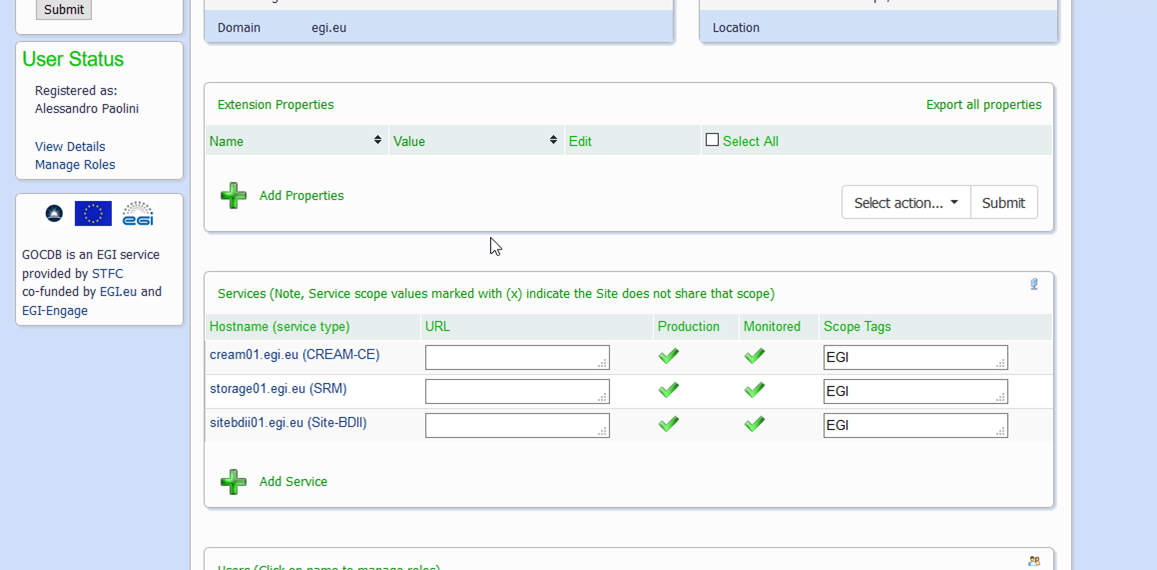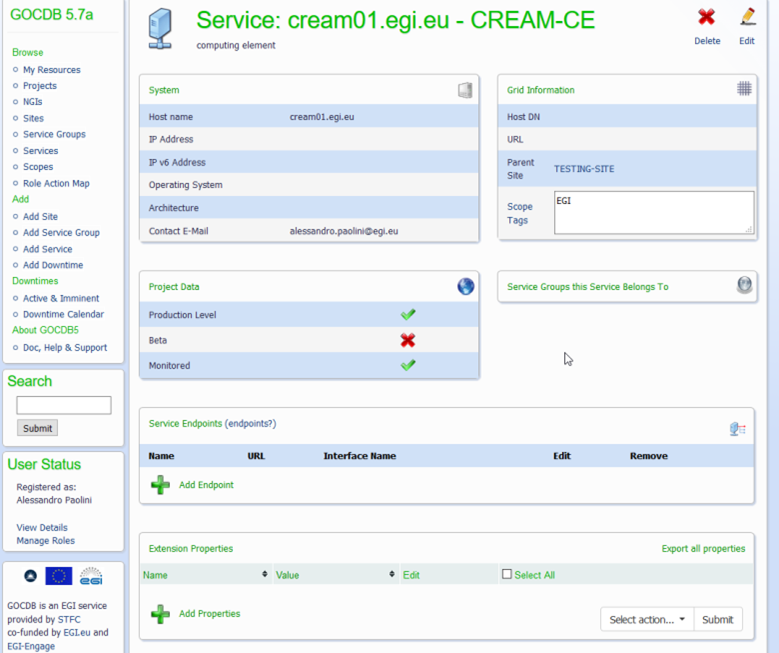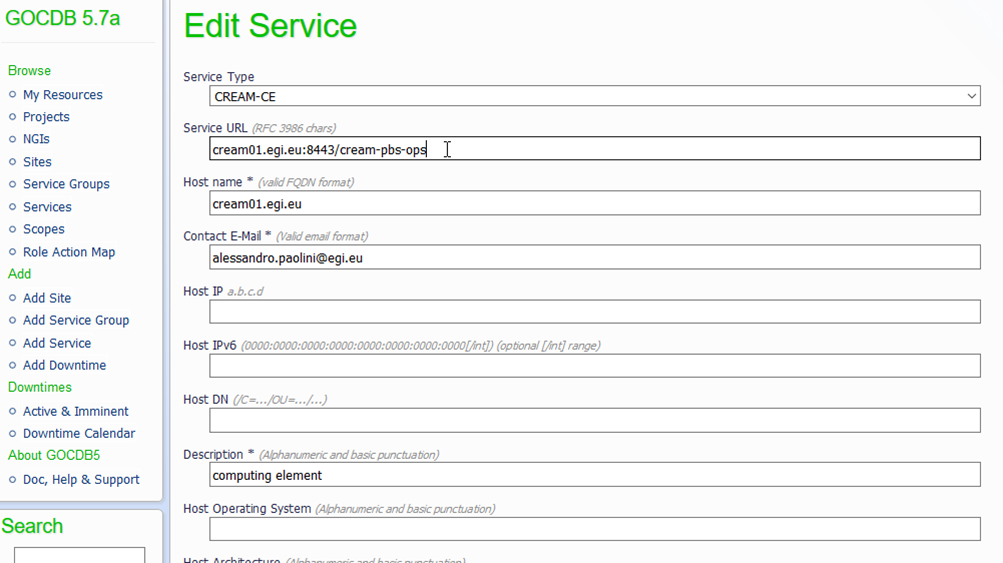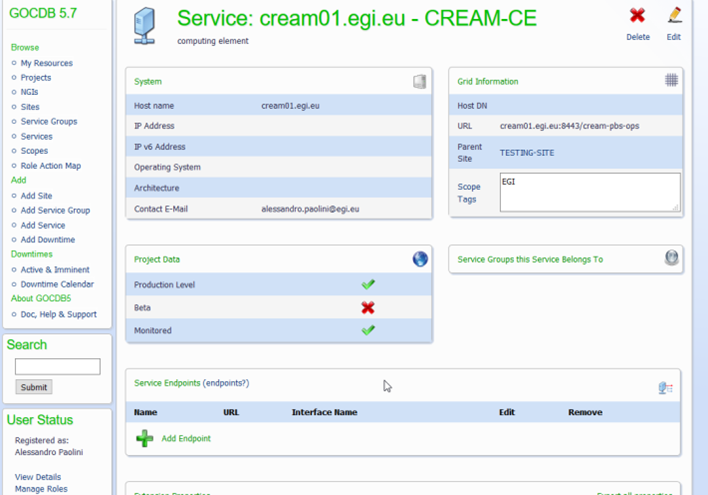Adding service endpoints
For monitoring purposes, each service endpoints registered into the Configuration Database, and having the flags production and monitored should include the endpoint URL information in order to be contacted by the corresponding service-specific nagios probe.
The information needed for service type are:
- SRM: the value of the attribute
GlueServiceEndpointpublished in the Configuration Database or BDII (e.g.httpg://se.egi.eu:8444/srm/managerv2) - Cloud:
- org.openstack.nova: The
endpoint URLmust contain the Keystone v3 URL:https://hostname:port/url/v3 - org.openstack.swift:The
endpoint URLmust contain the Keystone v3 URL:https://hostname:port/url/v3 - eu.egi.cloud.accounting: for the host sending the records to the accounting repository
- org.openstack.nova: The
- Other service types: the value of the attribute
GlueServiceEndpointpublished in the BDII
It is also possible to register additional endpoints for every services, they will also be monitored if the “Monitored” flag is set.
For having more information about managing the Service endpoints in the Configuration Database, please consult the service endpoints documentation.
Retrieving the information
For retrieving the queue URL from the BDII, you can use the command
lcg-infosites, to be executed from a UI. Be sure to query a production Top
BDII: you can either use the one provided by your Operations Centre or choose
one from
the Configuration Database
For example:
$ export LCG_GFAL_INFOSYS=egee-bdii.cnaf.infn.it:2170
$ lcg-infosites --vo ops ce | grep nikhef
5680 15 0 0 0 dissel.nikhef.nl:2119/jobmanager-pbs-infra
5680 17 1 1 0 gazon.nikhef.nl:8443/cream-pbs-infra
5680 15 0 0 0 juk.nikhef.nl:8443/cream-pbs-infra
5680 15 0 0 0 klomp.nikhef.nl:8443/cream-pbs-infra
5680 16 0 0 0 stremsel.nikhef.nl:8443/cream-pbs-infra
In order to find the GlueServiceEndpoint URL of your SRM service, you can
launch a LDAP query to your Site BDII (or directly to the SRM service):
$ ldapsearch -x -LLL -H ldap://sbdii01.ncg.ingrid.pt:2170 \
-b "mds-vo-name=NCG-INGRID-PT,o=grid" \
'(&(objectClass=GlueService)(GlueServiceType=SRM))' \
GlueServiceEndpoint
dn: GlueServiceUniqueID=httpg://srm01.ncg.ingrid.pt:8444/srm/managerv2,Mds-Vo-name=NCG-INGRID-PT,o=grid
GlueServiceEndpoint: httpg://srm01.ncg.ingrid.pt:8444/srm/managerv2
In a similar way, by just changing the value of GlueServiceType, you can
retrieve the endpoint URLs of other services.
An alternative way for retrieving the GlueServiceEndpoint URL is using the
GLUE2 information browser provided by
VAPOR: select
your NGI, then your site and hence the Storage service; click on the endpoint
details button for finding the URL associated to the SRM interface.
Filling the information in
URLs information are completely missing
Editing the services information
- Site overview
This is the home page regarding your site. You need to fill in the URL information.
Click on a service for displaying its page (e.g. the CREAM-CE).

- Editing a service
Click on the EDIT button in the top right corner

- Adding a Service URL
fill in the Service URL field with the queue URL

- Reviewing the site
Now the CREAM-CE service endpoint contains the required queue information.
Proceed in a similar way for the other services.

Additional endpoints information
In case you need to register an additional endpoint for a service, go on the service summary page and add the proper information. In the example below it is shown the case of a computing element.
- Service summary page
This is the service summary page.
You need to click on the Add endpoint button for registering additional endpoint URLs.

- Adding an endpoint
Fill in the proper information and don’t forget to select the “Monitored” flag for making Nagios to detect the new endpoint.

- Reviewing the endpoint description
The summary page of the endpoint just added should look like this one.

- Reviewing the service description
And this is the summary page of the service reporting the information about all its endpoints registered: the first one in the Grid Information section and the additional ones in the Service Endpoints section.

Examples
webdav
In order to properly monitor your webdav endpoint:
- you should register a new service endpoint with the webdav service type, separated from the SRM one;
- the endpoint URL information used for monitoring purposes should be set in the
extension properties section. Create the following:
- Name: ARGO_WEBDAV_OPS_URL
- Value: webdav URL containing also the VO ops folder, for example:
https://darkstorm.cnaf.infn.it:8443/webdav/opsorhttps://hepgrid11.ph.liv.ac.uk/dpm/ph.liv.ac.uk/home/ops/- it corresponds to the value of GLUE2 attribute
GLUE2EndpointURL(containing the used port and without the VO folder);
- it corresponds to the value of GLUE2 attribute
- verify that the webdav URL (for example:
https://darkstorm.cnaf.infn.it:8443/webdav) is properly accessible.
EOS and XrootD service endpoints
The EOS service endpoints expose an XrootD interface, so in order to properly monitor them, even in case you provide a plain XrootD endpoint, please do the following:
- you should register a new service endpoint with the XrootD service type;
- the endpoint URL information used for monitoring purposes should be set in the
extension properties section. Create the following:
- Name: ARGO_XROOTD_OPS_URL
- Value: XRootD base SURL to test (the path where ops VO has write access),
for example:
root://eosatlas.cern.ch//eos/atlas/opstest/egi/,root://recas-se-01.cs.infn.it:1094/dpm/cs.infn.it/home/ops/,root://dcache-atlas-xrootd-ops.desy.de:2811/pnfs/desy.de/opsor similar). Pay attention to the port configured for the interface.
GridFTP
In order to properly monitor your gridftp endpoint for ops VO
- register a new service endpoint, associating the storage element hostname to
the service type
globus-GRIDFTP, with the “production” flag disabled; - in the “Extension Properties” section of the
service endpoint page, fill in the following fields:
- Name: SE_PATH
- Value:
/dpm/ui.savba.sk/home/ops(this is an example, set the proper path)
- check if the tests are OK (it might take some hours for detecting the new service endpoint) and then switch the production flag to “yes”
SURL value for SRM
The SURL value needed by the SRM monitoring probes is the following structure:
srm://<hostname>:<port>/srm/managerv2?SFN=<GlueSAPath or GlueVOInfoPath>
For example:
srm://ccsrm.in2p3.fr:8443/srm/managerv2?SFN=/pnfs/in2p3.fr/data/dteam/
- As explained in previous sections, you can retrieve the port number from the
GlueServiceEndpointURL information. - If your SE provides
GlueSAPathinformation, use that. To retrieve it:
$ ldapsearch -x -LLL -H <ldap://sbdii01.ncg.ingrid.pt:2170> \
-b "mds-vo-name=NCG-INGRID-PT,o=grid" \
'(&(objectClass=GlueSA)(GlueSAAccessControlBaseRule=VO:ops))' \
GlueSAPath GlueChunkKey
dn: GlueSALocalID=opsdisk:replica:online,GlueSEUniqueID=srm01.ncg.ingrid.pt,Mds-Vo-name=NCG-INGRID-PT,o=grid
GlueChunkKey: GlueSEUniqueID=srm01.ncg.ingrid.pt
GlueSAPath: /gstore/t2others/ops
- if your SE doesn’t provide
GlueSAPathinformation, use instead theGlueVOInfoPathone:
$ ldapsearch -x -LLL -H <ldap://ntugrid5.phys.ntu.edu.tw:2170> \
-b "Mds-Vo-name=TW-NTU-HEP,o=grid" \
(&(objectClass=GlueVOInfo)(GlueVOInfoAccessControlBaseRule=VO:ops)) \
GlueVOInfoLocalID GlueChunkKey
dn: GlueVOInfoLocalID=ops:SRR,GlueSALocalID=SRR:SR:replica:*****,GlueSEUniqueID=ntugrid6.phys.ntu.edu.tw,Mds-Vo-name=TW-NTU-HEP,o=grid
GlueVOInfoPath: /dpm/phys.ntu.edu.tw/home/ops
GlueChunkKey: GlueSALocalID=SRR:SR:replica:*****
GlueChunkKey: GlueSEUniqueID=ntugrid6.phys.ntu.edu.tw
GlueVOInfoLocalID: ops:SRR
dn: GlueVOInfoLocalID=ops:data01,GlueSALocalID=data01:replica:online,GlueSEUniqueID=ntugrid6.phys.ntu.edu.tw,Mds-Vo-name=TW-NTU-HEP,o=grid
GlueVOInfoPath: /dpm/phys.ntu.edu.tw/home/ops
GlueChunkKey: GlueSALocalID=data01:replica:online
GlueChunkKey: GlueSEUniqueID=ntugrid6.phys.ntu.edu.tw
GlueVOInfoLocalID: ops:data01
- Pay attention to use the storage path for the ops VO
- On GOCDB, in the “Extension Properties” section of
the SRM service endpoint page, fill in the following fields:
- Name: SURL
- Value: the actual SURL value, for example:
srm://srm01.ncg.ingrid.pt:8444/srm/managerv2?SFN=/gstore/t2others/ops